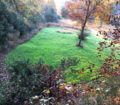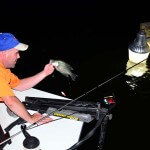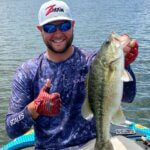Editor’s Note: In states where baiting is legal, the timing and the placement of the feeder determines the hunter’s success. Be sure to check your state’s regulations governing using feeders. Hunting a feeder hard the first year can keep the deer away in future years; and the placement of the feeder is very important to your success.
 Florida has always considered baiting legal, and my longtime friend and avid hunter, Ronnie Grooms of Panama City, Florida, has hunted around feeders for many years. According to Grooms, “For a feeder to be effective, you shouldn’t hunt it for several years. Deer are very shy of a feeder the first year you put it out. To create and develop an area where you can bag big bucks with your bow, the does must bring their fawns to the feeder and feel comfortable feeding around it. Then, as those buck fawns grow and develop, they’ll be accustomed to the feeder and feed in daylight hours around it. But if you hunt deer around a feeder the first year you put it out, the does will quickly learn there’s danger at the feeder; and they’ll teach that fact to their babies, especially to their buck fawns.”
Florida has always considered baiting legal, and my longtime friend and avid hunter, Ronnie Grooms of Panama City, Florida, has hunted around feeders for many years. According to Grooms, “For a feeder to be effective, you shouldn’t hunt it for several years. Deer are very shy of a feeder the first year you put it out. To create and develop an area where you can bag big bucks with your bow, the does must bring their fawns to the feeder and feel comfortable feeding around it. Then, as those buck fawns grow and develop, they’ll be accustomed to the feeder and feed in daylight hours around it. But if you hunt deer around a feeder the first year you put it out, the does will quickly learn there’s danger at the feeder; and they’ll teach that fact to their babies, especially to their buck fawns.”
Where you place your feeder also determines the success of that feeder. In Texas and other desert states, putting a feeder in a wide-open field or a pasture may pay buck dividends. But Grooms feels that deer, especially in the East, prefer to come to the feeder through thick cover before stepping out into an opening and feeding. Then at the first sight of danger, they can quickly jump back in that thick cover and escape.
“If you put your feeder in a thicket or on the edge of a thicket, you’re much more likely to lure in big bucks during daylight hours than if you have your feeder on the edge of a pasture,” Grooms reports. “The more open country a buck has to cross to get to the feeder, the less likely that buck will be to come to the feeder during daylight hours.”
 Most hunters who bag deer with their bows over bait have learned they increase the effectiveness of hunting at a deer feeder if they place their tree stands near trails leading to that feeder. Then, if anyone shoots at a deer and misses or even bags that deer on the trail leading to the feeder, the deer won’t likely discontinue coming to the feeder during daylight hours. The deer may change trails and use different approaches to the feeder. But most deer actively will use a feeder, as long as no one takes shots at them at the feeder site. The further away from the feeder you set-up your tree stand, the less likely that you’ll spook the deer utilizing the feeder.
Most hunters who bag deer with their bows over bait have learned they increase the effectiveness of hunting at a deer feeder if they place their tree stands near trails leading to that feeder. Then, if anyone shoots at a deer and misses or even bags that deer on the trail leading to the feeder, the deer won’t likely discontinue coming to the feeder during daylight hours. The deer may change trails and use different approaches to the feeder. But most deer actively will use a feeder, as long as no one takes shots at them at the feeder site. The further away from the feeder you set-up your tree stand, the less likely that you’ll spook the deer utilizing the feeder.
What time the feeder goes off also influences the productiveness of a feeder. If the feeder regularly comes on just before daylight to enable deer to feed during that first 10 to 15 minutes of shooting light, you’ll have a better chance of bagging a deer close to the feeder. Set your tree stand up near the trail toward the bedding area to take a shot as the deer come away from the feeder. Many hunters like to set their feeders to go off at dawn and dusk. When deer come to a feeder at dusk, you can set-up close to the feeder to see the animals when they feed just before nightfall. However, you’ll find that setting-up well down the trail the deer use to come to the feeder before it slings the feed a far-more-productive tactic. You’ll have less-wary deer to hunt and have more light to take your shot the further you’ve set-up on the trail away from your feeder.
Bowhunters in states that have legalized feeders need to remember that the more they shoot and hunt around the same feeder, the less often deer will feed there during daylight hours. If you hunt away from the feeder, deer usually will continue using that feeding site during daylight hours, even if they feel hunting pressure on the way to and from that bait. You can bait deer even in states that don’t permit baiting. Even though other hunters may walk through an area you’ve baited, they’ll never see the bait or understand why you can take deer in that particular spot. Everyone who bowhunts bags about 80 percent of the deer harvested each season as the deer move to some kind of feed – agricultural crops, acorns, fruit orchards and/or a feeder.
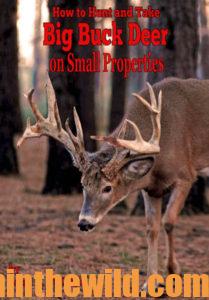 To learn more about deer hunting, go to John E. Phillips’ books and learn the tactics small property owners have used successfully by checking out John E. Phillips’s book, “How to Hunt and Take Big Buck Deer on Small Properties” at https://www.amazon.com/dp/B00OOC2T0Y#, available in Kindle, print and Audible versions.
To learn more about deer hunting, go to John E. Phillips’ books and learn the tactics small property owners have used successfully by checking out John E. Phillips’s book, “How to Hunt and Take Big Buck Deer on Small Properties” at https://www.amazon.com/dp/B00OOC2T0Y#, available in Kindle, print and Audible versions.
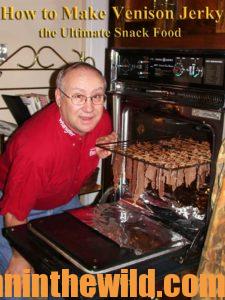 To receive your free book on “How to Make Venison Jerky,” go to https://www.emailmeform.com/builder/form/Ece3UZVcOo52cKPJcL.
To receive your free book on “How to Make Venison Jerky,” go to https://www.emailmeform.com/builder/form/Ece3UZVcOo52cKPJcL.
Tomorrow: How to Use Invisible Bait to Call in Deer Legally


